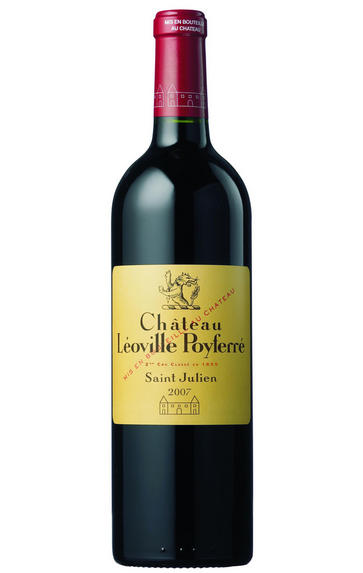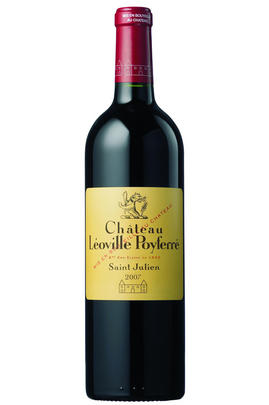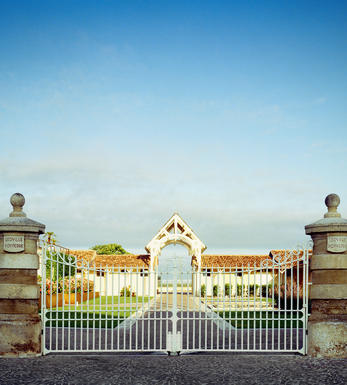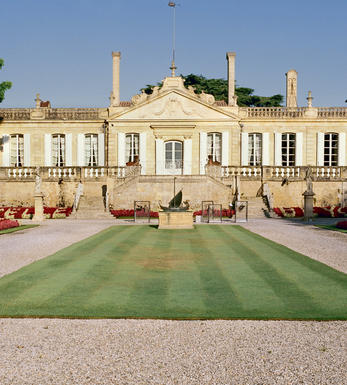
1996 Château Léoville Poyferré, St Julien, Bordeaux

Critics reviews
Neal Martin - 28/10/2016
(Jancis Robinson - Bordeaux '96s Today - jancisrobinson.com - 21-Sept-2011)
About this WINE

Château Léoville Poyferré
Château Léoville Poyferré is a wine estate in St Julien on the Left Bank of Bordeaux. It was once part a larger estate called Léoville, which was established in 1638 and divided up centuries later following the death of its owner. That original estate gave rise to the three separate properties now called Léoville Barton, Léoville Las Cases and Léoville Poyferré. The latter took its name in 1840 from Baron Jean-Marie de Poyferré, who inherited the estate along with his wife, the daughter of Jeanne de Las Cases. Léoville Poyferré, like Barton and Las Cases, was ranked a Second Growth in the 1855 classification.
The estate has been owned and run since 1920 by the Cuvelier family. Having established themselves as wine merchants in Lille in Northern France, the family had recently bought Château Le Crock in St Estèphe before expanding into St Julien with both Léoville Poyferré and Château Moulin Riche. The family firm is led today by Sara Lecompte Cuvelier, who took over from her uncle Didier Cuvelier in 2017. She works with long-time winemaker Isabelle Davin. Michel Rolland has been the consultant here since the mid-1990s.
The portfolio here includes the grand vin, Château Léoville Poyferré, along with the estate’s second wine, Pavillon de Léoville Poyferré. Moulin Riche was once considered an unofficial second wine of Léoville Poyferré but has since 2009 been very much its own estate wine.

St Julien
St Julien is the smallest of the "Big Four" Médoc communes. Although, without any First Growths, St Julien is recognised to be the most consistent of the main communes, with several châteaux turning out impressive wines year after year.
St Julien itself is much more of a village than Pauillac and almost all of the notable properties lie to its south. Its most northerly château is Ch. Léoville Las Cases (whose vineyards actually adjoin those of Latour in Pauillac) but, further south, suitable vineyard land gives way to arable farming and livestock until the Margaux appellation is reached.
The soil is gravelly and finer than that of Pauillac, and without the iron content which gives Pauillac its stature. The homogeneous soils in the vineyards (which extend over a relatively small area of just over 700 hectares) give the commune a unified character.
The wines can be assessed as much by texture as flavour, and there is a sleek, wholesome character to the best. Elegance, harmony and perfect balance and weight, with hints of cassis and cedar, are what epitomise classic St Julien wines. At their very best they combine Margaux’s elegance and refinement with Pauillac’s power and substance.
Ch. Léoville Las Cases produces arguably the most sought-after St Julien, and in any reassessment of the 1855 Classification it would almost certainly warrant being elevated to First Growth status.
Recommended Châteaux: Ch. Léoville Las Cases, Ch.Léoville Barton, Ch Léoville Poyferré, Ch. Ducru-Beaucaillou, Ch Langoa Barton, Ch Gruaud Larose, Ch. Branaire-Ducru, Ch. Beychevelle

Cabernet Sauvignon Blend
Cabernet Sauvignon lends itself particularly well in blends with Merlot. This is actually the archetypal Bordeaux blend, though in different proportions in the sub-regions and sometimes topped up with Cabernet Franc, Malbec, and Petit Verdot.
In the Médoc and Graves the percentage of Cabernet Sauvignon in the blend can range from 95% (Mouton-Rothschild) to as low as 40%. It is particularly suited to the dry, warm, free- draining, gravel-rich soils and is responsible for the redolent cassis characteristics as well as the depth of colour, tannic structure and pronounced acidity of Médoc wines. However 100% Cabernet Sauvignon wines can be slightly hollow-tasting in the middle palate and Merlot with its generous, fleshy fruit flavours acts as a perfect foil by filling in this cavity.
In St-Emilion and Pomerol, the blends are Merlot dominated as Cabernet Sauvignon can struggle to ripen there - when it is included, it adds structure and body to the wine. Sassicaia is the most famous Bordeaux blend in Italy and has spawned many imitations, whereby the blend is now firmly established in the New World and particularly in California and Australia.


Buying options
Add to wishlist
Description
For a long time this estate was the poor relation of the Léoville clan, however, improvements in quality have been noticeable since the early 1990s and 1996 was a real success for Poyferré. The château traditionally produced the softest and most supple wine of the three Léovilles, yet the wines have definitely put on weight and body. This is largely due to the grapes being harvested riper and later, and because of the increased exposure to new oak in the maturation process. The wines are now up with the best of the St Juliens, but still selling at non-scary prices.
The nose sings with notes of oak, forest fruits, truffles and tobacco leaves while the palate reveals impressive fruit concentration, a fleshy full-bodied structure and a harmonious integration of fruit and tannins.
wine at a glance
Delivery and quality guarantee